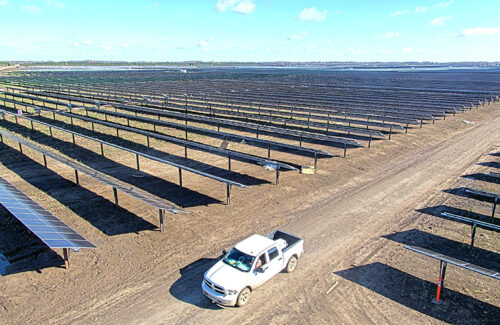
A solar project in Ohio by EDF renewable energy sources.
The Senate of Ohio has unanimously approved a state’s energy policy via House account 15 On April 30, 2025, and the Ohio House later agreed on the same day by a vote from 94 to 2. The legislation is now going to GOV. Mike Dewine for his approval.
An earlier version of the bill contained a Community Energy Pilot program that would have included Solar, but that provision did not come to the latest legislation.
HB 15, together with his accompanying bill, Senate Bill 2, proposed wholesale changes in Ohio’s approach to energy. Below is a summary of some of the most important provisions of the bill by a law firm Bricker Graydon:
- Tax reform starts in tax year 2027:
- Low the tangible personal property (TPP) tax on new generation and energy conversion equipment to 7% of 25%.
- Put the TPP on new transmission, distribution and pipeline infrastructure to 25%.
- Existing payment instead of taxes (pilot) agreements will continue.
- Energy storage is treated as a generation for the purposes of the TPP.
- Priority investment areas (PIA)
- Local communities may apply to the Ministry of Development to designate areas as PIA. Brownfields and former mining sites are eligible for PIA indication.
- PIA -Handlijd projects can be awarded up to $ 10 million from the Brownfield Remediation Program.
- PIA projects receive accelerated assessment by the OWSB and a TPP tax exemption on transmission, distribution and pipeline infrastructure for five years.
- Appropriate the customer’s repayments for rates that were later established illegally. Restitutions are issued from the date on which the Ohio Supreme Court states that a rate was illegal.
- Retains colens subsidies on the Ohio Valley Electric Company (OVEC) immediately after the effect of the account.
- Relates the limited solar subsidies created by HB 6 in 2019 in 2019. This new fund, which must be managed by the OHIO Facilities Construction Commission, provides loans to pay for energy saving, repayment contracts and energy -saving measures. This includes the installation of solar panels.
- Retractor of electrical security plans and requires you to be submitted for 3 years for electric distribution utensils (EDUs).
- Puco “Shot Clocks” for speed cases.
- Requires a period of 360 days for tariff cases once an application has been submitted.
- Personnel reports must be completed in 180 days.
- Exempt new discovery after 215 days.
- The Ohio Power Siting Board is required to complete all cases within 150 days after an application is considered complete.
- Expand the chances for the back-the-meter generation.
- Requires EDUs to publish capacity cards and heat cards of their systems.
- Contains definitions of ‘advanced transmission technologies’, ‘advanced conductor’ and provisions that are designed to study both the use of ‘Grid-Burgering technologies’, also known as GETS.
The Action Fund of Ohio Environmental Council (OEC) praised the legislation in a statement by Nolan Rutschilling, director of energy policy:
“The OEC Action Fund, our members and our partners have been fighting for years to eliminate the OVEC Coal Bailout created by the Bill 6 Corruption scandal house, and to create more just, transparent regulation of electric utensils. Today we have achieved a significant victory, and OH and OH and OHS and OHS and OH’s Rising and OH and OHS and OH NUTSADANS and Royal Dance Related, and Oh -Nutscaans and Royal Dance Related, and Oh -Nutsdonance, and that related to Fine, and Oh -Nutsdonance, and that related, and Rising Air, and Rising Air, and that Rising Air Royalans. Bills.
“This legislation will enable the OEC Action Fund and our partners to continue our struggle for a cleaner, more reliable and affordable energy system, and it is the result of tireless work of the proponents of Ohio’s environment and energy rights. We have much more work to do, but today OHIO has a step for a more equitable law.

